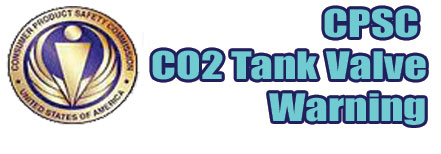  |
|
|
|
|
|
|
  |
|
|
|
|
|
|

CPSC Release What do you think? Add your comments in WARPIG's Forums
|

CPSC Issues Paintball Warning
On March 24, 2004 the Consumer Product Safety Commission issued a safety warning (release #04-104) regarding paintball. The CPSC is a consumer safety watchdog organization that is a part of the US government. The safety warning is the result of an investigation into two deaths within the last year caused by CO2 tanks separating from their valves and causing fatal injuries as the tanks launched themselves away from the paintgun, propelled by expanding gas. In both cases the CO2 tanks unscrewed from their valves, rather than the valves unscrewing from the paintguns. The first accident, which claimed the life of a teenager occurred in summer of 2004 and has lead to lawsuits against not only the tank manufacturer, but the dealer who sold the product as well. The most recent of these two accidents took the life of a woman who was throwing a paintball birthday party for her son in Placerville, California. California airsmith Glenn Palmer, owner of Palmer’s Pursuit shop had the opportunity to investigate the tank and valve from the Placerville accident. As the equipment was subject to an ongoing government investigation, he was not allowed to touch the equipment, or remove the valve from the paintgun’s bottom-line air system adapter to determine how tightly it was stuck, or why. According to Palmer the tank had been modified from its originally manufactured state. An anti-siphon tube had been added to the valve so that it would draw gaseous CO2 instead of liquid when the tank was screwed all the way in to the paintgun’s ASA. Local law enforcement told Palmer that their investigation had not identified the person responsible for the modification, as the tank and paintgun were purchased used through an Internet auction. Palmer noted that the threads on the valve neck and tank appeared to be mechanically sound. He also spotted no signs of thread locking compound on the valve neck. Palmer states that historically the Department of Transportation specifications for valve installation have not required thread locking compound, but specify higher torque ratings for “dry” valve installation. It is common practice in the paintball industry to use a thread-locking compound when installing CO2 tank valves. This is also true for screw-in style compressed air systems, though some cradle mounted HPA systems are set up with user-removable tanks without thread locker. These types of air systems are not unscrewed from a paintgun in normal use under pressure, greatly decreasing the risk of accidental separation.
Additionally the valve or regulator necks are much longer, requiring many more turns for removal than needed to remove the valve from the paintball gun. Palmer summed up the situation by saying,
“All indications to me are that the valve was not torqued adequately into
the tank when the anti-siphon tube was installed. In my professional
opinion, whoever had the valve out of the tank last, did not re-install
it properly.”
Fortunately the CPSC has not painted a picture of paintball as unnecessarily dangerous. Instead, it is making an effort to spread information to the public to reduce the chance of these types of accidents in the future. In it’s release, the CPSC included the
following advice:
The Consumer Product Safety Commission is continuing to investigate both accidents. This release marks the CPSC’s second warning concerning the sport of paintball, the first of which reported the 1998 voluntary recall of Leader goggle lenses which were distributed by Brass Eagle. Leaving maintenance, repair and upgrading of compressed gas systems to the hands of trained professionals, and being observant when handling those systems are the keys to keeping paintball’s safety record in good shape. Editor’s Note: The staff of WARPIG.com
extends their condolences to and prayers for the families and friends of
those who lost their lives in these unfortunate, accidents.
|
| Copyright © 1992-2019
Corinthian Media Services. WARPIG's webmasters can be reached through our feedback form. All articles and images are copyrighted and may not be redistributed without the written permission of their original creators and Corinthian Media Services. The WARPIG paintball page is a collection of information and pointers to sources from around the internet and other locations. As such, Corinthian Media Services makes no claims to the trustworthiness or reliability of said information. The information contained in, and referenced by WARPIG, should not be used as a substitute for safety information from trained professionals in the paintball industry. |